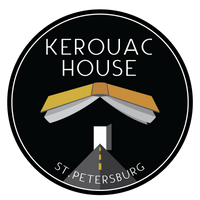JACK KEROUAC
Jean-Louis Lebris de Kérouac, known as Jack Kerouac, was an American novelist and poet perhaps best known as a pioneer of the Beat Generation, the first manifestation of the American counterculture that starts in the 1940’s and is still going strong. His first published book was The Town and the City (1950), but it was not until his second novel On the Road was published in 1957 that he became an internationally recognized artist and celebrity. On the Road made Kerouac an icon of the youth counterculture of the late 50’s and 60’s, and he would publish another twelve novels and numerous poetry volumes before his untimely death in St. Petersburg in 1969 at the age of 47.
Jack Kerouac’s cultural influence is twofold: as a literary innovator and the public face of the Beat Generation.Although his first novel was stylistically conventional, over the next few years Kerouac developed a new style and method of writing, what he called “spontaneous prose.” He famously wrote the first draft of what became On the Road in three weeks in 1951, but that manuscript was preceded by years of preparation and followed by years of editing and revision. However, the free-flowing, non-linear structure of Kerouac’s prose in that and subsequent works has the appearance of springing forth spontaneously from the author’s head, an apparent rejection of traditional literary stylistics and the dictum that art should be carefully and meticulously crafted. In this respect, Kerouac’s prose has much in common with similar developments in the visual, musical, theatrical, and even architectural arts of the 1950’s and 60’s.
Thematically, his work ranges widely, addressing topics such as Catholicism, jazz, travel, sexual promiscuity, Buddhism, drugs, alcoholism, classicism, racism, poverty, and the philosophies of language, mind, and spirit (to name a few). The artists of the Beat Generation and “Beatniks” in general were already controversial since their rejection of conservative, heteronormative, middle-class values was anathema to many Americans of the period. However, the emerging youth counterculture of the time embraced the Beats and the free-wheeling lifestyle they represented. With the publication of On the Road, Kerouac became an underground celebrity and, with other Beats like Allen Ginsberg, William Burroughs, Lawrence Ferlinghetti, and Gregory Corso, was seen as a progenitor of the cultural revolution that hit its peak in the 1960’s. While other artists were nearly as important to the cultural moment, Kerouac’s novels proved to be more accessible than say Ginsberg’s poems or Burroughs’ strange and experimental novels, and therefore were read by more people.
Between 1957 and his death in 1969 in St. Petersburg, Kerouac published fourteen works of fiction, about half of which were written prior to the publication of On the Road. After a few years of global - and unwanted – celebrity, Kerouac’s popularity and fame in mainstream American culture steadily decreased. However, his reputation as an underground iconoclast has steadily grown from that time until the present day. His books have been translated into many languages and are read and taught around the world. Moreover, the influence he has had upon writers, artists, and musicians over the last sixty years can not be overstated. From Bob Dylan to Death Cab for Cutie, Thomas Pynchon to Patti Smith, Steve Allen to Johnny Depp, artists from all over the world list Kerouac as a major influence on their work. Although Kerouac himself resisted his status as a cultural icon and the fame that came with it, he and his work have proven to be an enduring cultural force. It is this legacy and its expression into the future that we hope to promote and celebrate at the Jack Kerouac House of St. Petersburg.










